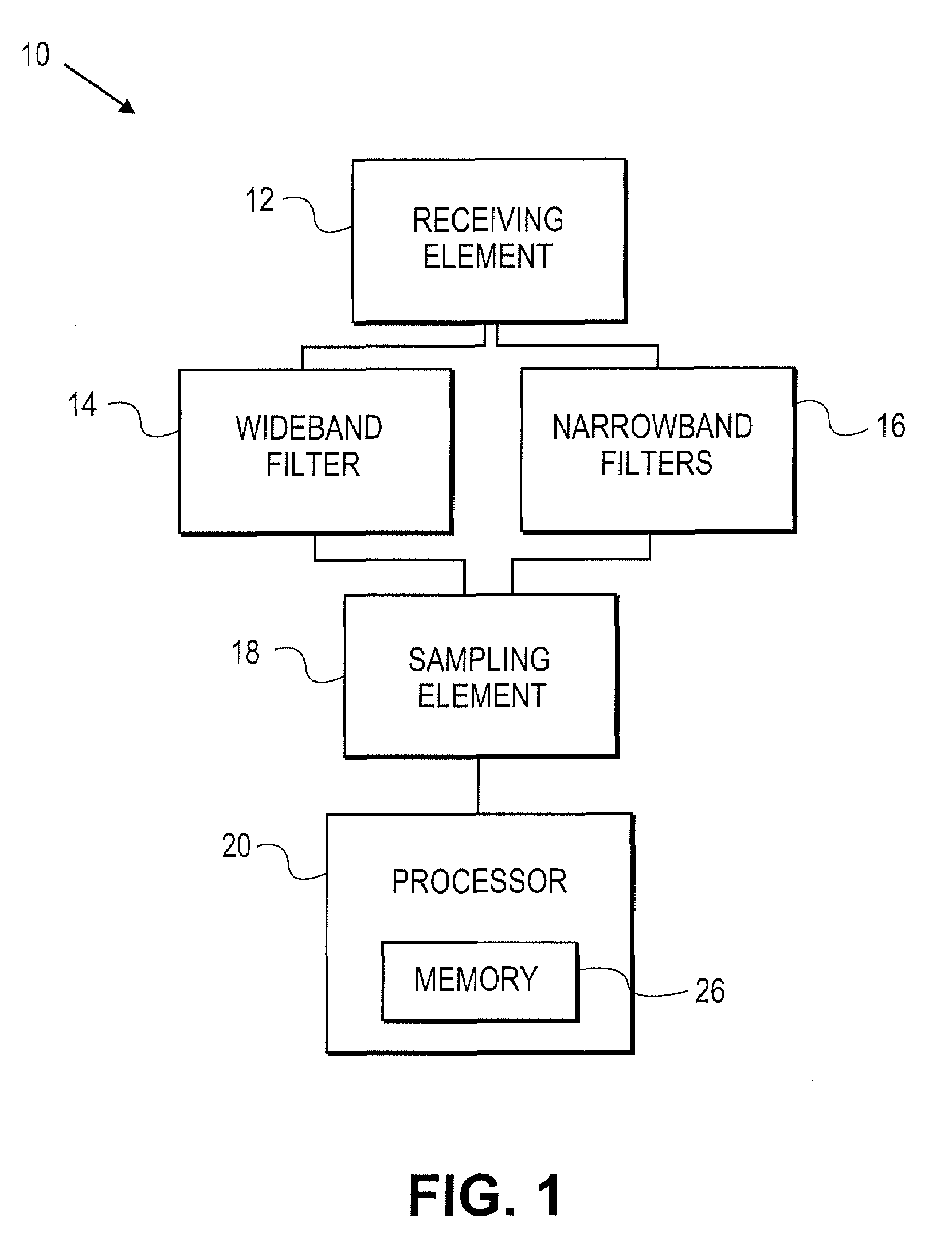[0007]The present invention solves the above-described problems and provides a distinct advance in the art of signal sampling and reconstruction. More particularly, the invention provides a method and apparatus for compressed sensing that utilizes a combination of non-uniform sampling in time along with sampling of narrowband frequency filters, in conjunction with a combined compressed sensing matrix to reconstruct an input signal. Utilization of a combined compressed sensing matrix enables an input signal to be sampled at less than the Nyquist rate and at least partially reconstructed.
[0008]In one embodiment, the present invention provides a method of reconstructing an input signal. The method generally comprises forming a first compressed sensing matrix utilizing a first set of time indices corresponding to a first sampling rate, forming a second compressed sensing matrix utilizing a plurality of frequencies and a second set of time indices corresponding to a second sampling rate, forming a combined compressed sensing matrix from the first compressed sensing matrix and the second compressed sensing matrix, and reconstructing at least a portion of the input signal utilizing the combined compressed sensing matrix. The first and second sampling rates are each less than the Nyquist sampling rate for the input signal.
[0009]In another embodiment, the present invention provides an apparatus for reconstructing an input signal. The apparatus generally includes a memory and a processor coupled therewith. The memory is operable to store data corresponding to a plurality of frequencies, a first set of time indices corresponding to a first sampling rate, and a second set of time indices corresponding to a second sampling rate. The first and second sampling rates are each less than the Nyquist sampling rate for the input signal. The processor is operable to form a first compressed sensing matrix utilizing data corresponding to the first set of time indices, form a second compressed sensing matrix utilizing data corresponding to the plurality of frequencies and the second set of time indices, form a combined compressed sensing matrix from the first compressed sensing matrix and the second compressed sensing matrix, and reconstruct at least a portion of the input signal utilizing the combined compressed sensing matrix.
[0010]In another embodiment, the present invention provides an apparatus for reconstructing an input signal. The apparatus generally includes a receiving element, a wideband filter coupled with the receiving element, a plurality of narrowband filters coupled with the receiving element, a sampling element coupled with the wideband filter and the narrowband filters, and a processor coupled with the sampling element. The sampling element is operable to sample the output of the wideband filter at a first sampling rate and sample the output of the narrowband filters at a second sampling rate. The first and second sampling rates are each less than the Nyquist sampling rate for the input signal. The processor is operable to form a first compressed sensing matrix utilizing a first set of time indices corresponding to the first sampling rate, form a second compressed sensing matrix utilizing a plurality of frequencies corresponding to the narrowband filters and a second set of time indices corresponding to the second sampling rate, form a combined compressed sensing matrix from the first compressed sensing matrix and the second compressed sensing matrix, and reconstruct at least a portion of the input signal utilizing the combined compressed sensing matrix.
[0011]In another embodiment, the present invention provides an apparatus for sampling an input signal. The apparatus generally includes a receiving element, a wideband filter coupled with the receiving element, a plurality of narrowband filters coupled with the receiving element, a sampling element coupled with the wideband filter and the narrowband filters, and a processor coupled with the sampling element. The processor is operable to process sampled signals for compressed sensing, direct detection, or conventional purposes.
[0012]In another embodiment, the present invention provides a computer program for reconstructing an input signal. The computer program is stored on a computer-readable medium for operating a processor and generally includes a code segment operable to form a first compressed sensing matrix utilizing a first set of time indices corresponding to a first sampling rate, a code segment operable to form a second compressed sensing matrix utilizing a plurality of frequencies and a second set of time indices corresponding to a second sampling rate, a code segment operable to form a combined compressed sensing matrix from the first compressed sensing matrix and the second compressed sensing matrix, and a code segment operable to reconstruct at least a portion of the input signal utilizing the combined compressed sensing matrix. The first and second sampling rates are each less than the Nyquist sampling rate for the input signal.
 Login to View More
Login to View More  Login to View More
Login to View More 


